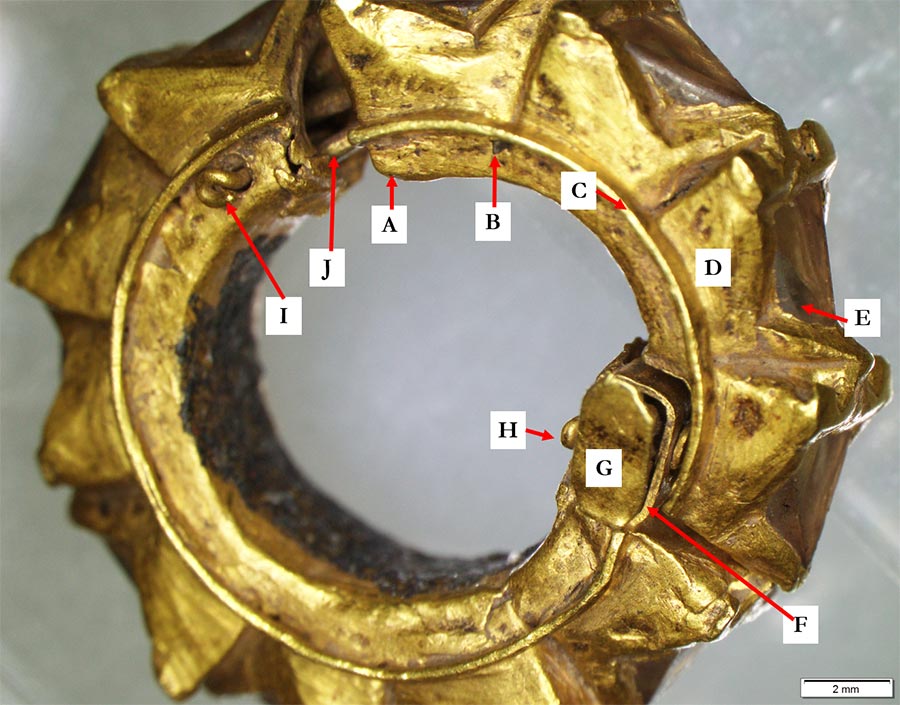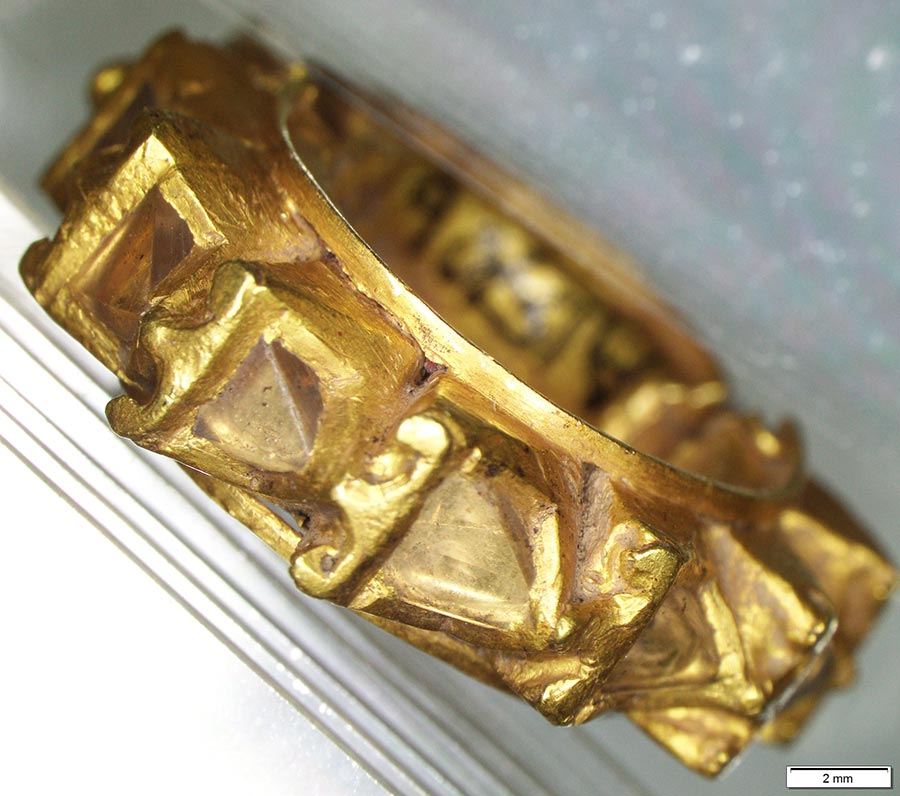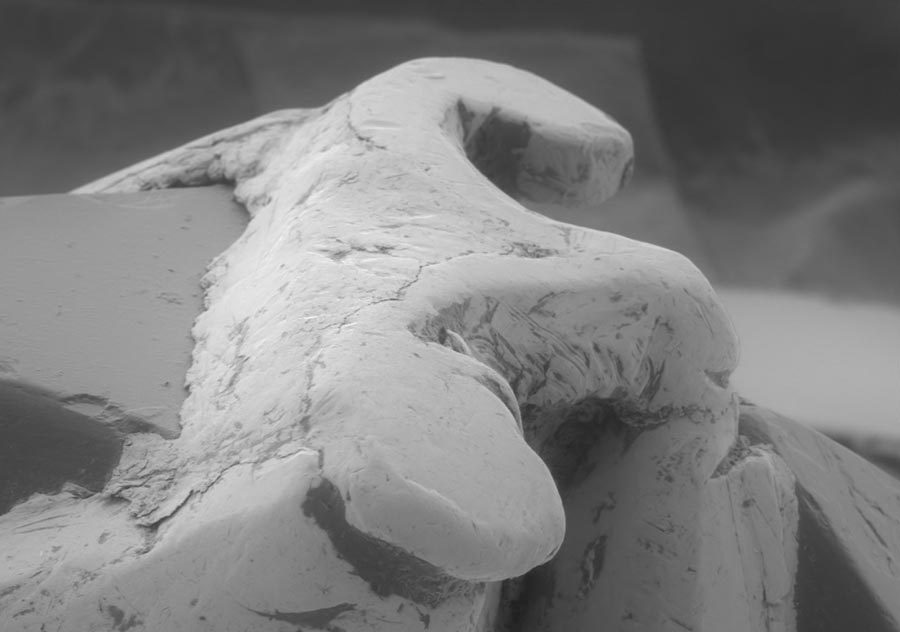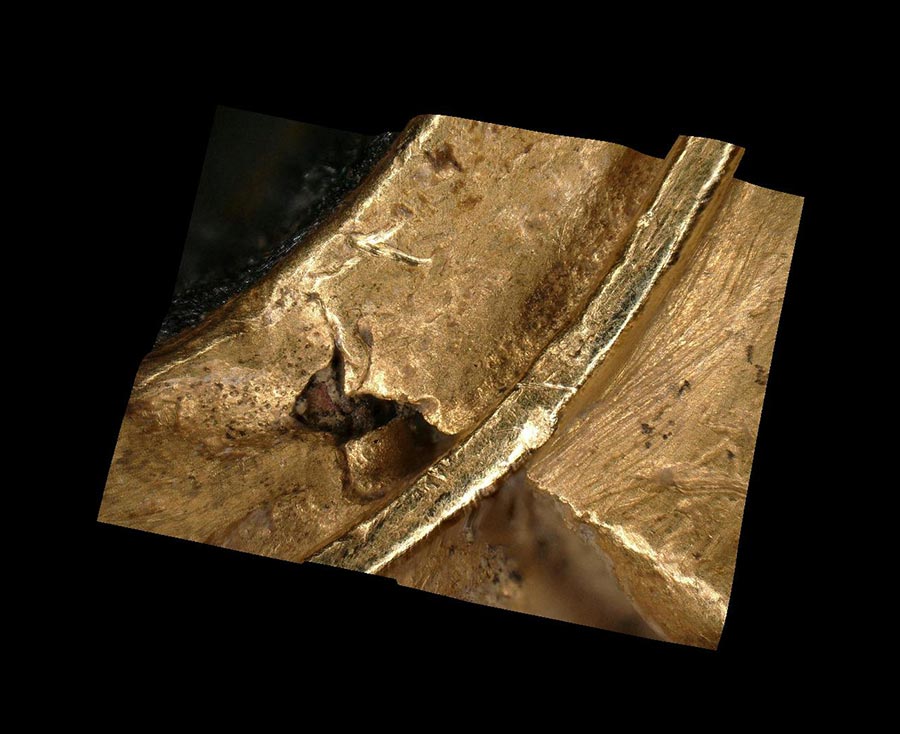Style and Substance: Investigating the Gold Ornaments of Ancient Temasek
On the 7th of July 1928, during excavations to clear the summit of Fort Canning Hill in Singapore, a trove of 11 gold objects was unearthed. Not long after the discovery, Sir Richard O. Winstedt, noted historian of Malaya, reported on the find in a four-page article. The Dutch archaeologist Dr. P.V. van Stein Callenfels was consulted on the identification of the artefacts, and they were ascribed to the East Javanese Majapahit period (late 13th to early 16th centuries CE). For almost 100 years, this label has prevailed and been regularly repeated to justify Majapahit hegemony over this part of the archipelago, thus providing Temasek’s raison d’être.
A Visiting Fellowship programme at the Temasek History Research Centre, ISEAS – Yusof Ishak Institute Singapore, provided the opportunity to review the existing ornaments and their identification, and to submit them to technical analysis. The scientific studies were conducted in collaboration with the Heritage Conservation Centre (HCC), the institution responsible for the conservation and preservation of Singapore’s National Collection, under the auspices of the National Heritage Board (NHB). 1 The original cache consisted of a pair of armbands with flexible chains, a conch and disc clasp, an elliptical ornament, an inscribed finger-ring, and six rings. Only three of the 11 ornaments remain today (one of the armlets and two of the six rings [Fig. 1]), most having disappeared during the Japanese Occupation of Singapore in 1948. 2 The armlet was the subject of the paper “The so-called ‘kala’ head armband of Temasek: A preliminary report,” soon to appear in the Temasek Working Paper Series. 3 Natalie S.Y. Ong, forthcoming, “The so-called ‘kala’ head armband of Temasek: A preliminary report”, Temasek Working Paper Series

Fig. 2: Parts of a ring: A) backing; B) core with reddish material; C) lateral protruding strip; D) setting; E) gemstone; F) socket; G) split pin; H) nail securing pin; I) nail securing hinge; J) wire hinge (Photo courtesy of ISEAS, 2022)
A complex construction
The rings were given a paragraph in Winstedt’s article and were described as a set of three pairs: “Six rings set each with 11 inferior diamonds of the Pontianak type (7 on one section and 4 on the other) and each having a flimsy bar-and-socket joint and a rude wire hinge.” 4 Winstedt also determines that they are “fragile, too clumsy in contour and far too narrow in diameter (outside 20 mm.; inside 10 mm.) to be finger or toe-rings.” He cites van Stein Callenfels, who identifies them as “of Javanese shape.” While most of the factual statements remain accurate, these observations pre-date technological advances and contemporary methods of scientific analysis, which now allow us to take a close look at the rings.
Under the microscope, specific features could be more clearly determined, and in addition to the general description given by Winstedt, it was found that the two rings were of elaborate construction and formed of several different elements [Fig. 2]. The main support structure was a backing that was divided into two parts, one smaller than the other, corresponding to the two sections mentioned by Winstedt. The 11 gemstones were each cut into a complex eight-sided shape with triangular and quadrangular facets, and each stone was embedded in a setting made of several layers of gold sheet [Fig. 3]. Each gem and setting formed a unit, which was then individually welded onto the backing. Each setting was also additionally and separately decorated with a triple-pronged shape that was attached to the surface to create a design resembling a crown to the modern eye [Fig. 4]. Once these were in place, a long narrow lateral protruding edge strip was welded at a 90-degree angle to the centre of each side of the ring [Fig. 5]. The two sections were then connected to each other by means of a wire hinge, and the opening had an interlocking socket through which a split pin was inserted, which allowed for easy removal or fastening. 5 A ring was not more than 20 mm in diameter, with internal parts such as the main facet of a gem measuring about 3 mm at its widest, and the lateral strip approximating 0.5 mm in width and 0.2 mm in thickness. The fineness of the construction probably contributed to the objects’ fragility, exacerbated by subsequent exposure to natural forces whilst underground. 6

Fig. 3: Stereomicroscope image of ring with gemstones, settings, design and lateral protruding strip (Photo courtesy of ISEAS, 2022)

Fig. 4: SEM image showing layers of gold foil with ‘crown’ design fused onto gemstone setting (Photo courtesy of ISEAS, 2022)
New findings
More interesting were two new findings. The first was that each ring was not made purely of solid gold and gemstone, but constructed of several layers of thin hammered gold. Notably, the backing consisted of gold sheet wrapped over a core of a bright reddish material, which could be observed at several locations where the rings were damaged, suggesting that the material had been intentionally used as the core [Fig. 6]. The loss of gold may indicate extensive wear prior to burial, which corroborates the evidence on the armlet. To test whether the red material was the product of seepage of elements, it was subjected to SEM-EDS and Raman spectrometry, 7 which identified the elements mercury (Hg) and sulphur (S). Mercury sulphide is more commonly known as cinnabar; in ancient times, this mineral was used as both the main source of the red pigment vermilion and of mercury for extracting gold from ores.
The second was the identification of the pale yellow precious stones, which were not diamonds as Winstedt and the Indian jewellers he mentions believed. The mislabelling may be understandable, since diamonds from the Pontianak region occur in shades ranging from colourless to pale yellow and even brown. 8 SEM-EDS imaging showed the presence of the chemical elements fluorine (F), aluminium (Al), and silicon (Si), which strongly indicates topaz, Al2SiO4(F, OH)2. In the 17th century, the well-travelled French gem merchant Jean-Baptiste Tavernier informs us that Ceylon and the Kingdom of Pegu (lower Myanmar) were the only two places in the East where topaz and other coloured precious stones originated. 9
Clearly, none of the above raw materials could have been found in Singapore. Gold is plentiful in Southeast Asia, with the closest sources to Temasek in the Malay Peninsula and the neighbouring island of Sumatra, where cinnabar was also mined in the 19th century. 10 Other possible sources of cinnabar include China, Sarawak, or Ceylon. Song-era chronicles (10th–13th centuries CE) inform us that it was a staple trade good to Java, where it was mainly used for cosmetics and dyes. 11
Sophisticated symbols
It is much less obvious why cinnabar would be used as a core material in an article of personal adornment, although the mineral has been found embedded in gold artefacts from the first-century Seogam-ri Tomb in South Korea. 12 On the Korean royal ornaments, however, the red pigment figured noticeably as part of the surface decoration, whereas in the case of the rings from Temasek, the mineral is entirely covered in gold sheet. On the one hand, this provided some protection to the wearer from direct contact with the mercury within the ore (which we now know is toxic). It may also have protected the mineral somewhat from the elements and erosive forces while the objects lay buried. On the other hand, the gold sheet also hid the presence of the cinnabar from the naked eye. Concealment may have been intended; in at least one case, cinnabar was included in a deposit purposefully buried beneath a shrine at Santubong in Sarawak, 13 suggesting ritualistic meaning relating to its natural properties. The colour red has, for example, long had symbolic value in many Asian cultures, and mercury was closely associated with alchemical and Tantric practices in both Indic and Sinic contexts. 14
In a similar manner, much significance has been attached to both the gold and the gemstones, the latter often deemed heralds of fortune or calamity. The lore laid out in Mani-Mala, A Treatise on Gems shows the multifarious beliefs and practices associated with precious stones, 15 and topaz is not exempt from this treatment. Topaz is generally said to confer fertility on women, but of the many legends connected to it, the ones of note belong to the Indic cosmological system, which is well known to have greatly influenced Southeast Asian culture in the first millennium of our era. The topaz is regarded as one of the nava-ratna (“nine precious gems”) associated with the nava-graha (“nine planets”), each presided over by deities linked to specific varna (“colour”), vahana (“vehicle”), and attributes. 16 Each having dominion over certain aspects of life, the wearer of such gemstones invokes their power.

Fig. 5: 3D digital microscope image of lateral protruding strip (Photo courtesy of ISEAS, 2022)
Most available texts on Indic gemmology tend strongly towards Hindu mythology, where topaz is identified with the divinity Brihaspati. Brihaspati first appears in the Rig Veda. The deity was born from light and drives away the darkness with thunder, becoming guru of gurus to the gods themselves and synonymous with the knowledge and intelligence of the sage. In later Puranas, Brihaspati’s devotion to Siva earns him lordship over the planet Jupiter. Both he and the gem are associated with Thursday and the Northwest direction, and the deity’s vehicle varies according to the region – goose, tiger, or chariot.
This summary of the deity over millennia is necessarily brief, but some elements appear to line up with the other artefacts of the discovered cache. For instance, the inscribed ring of a bird shown in Winstedt’s article may be related to Brihaspati’s goose vehicle, or the goose can represent one of Visnu’s avatars. Another reference to Visnu may lie in the now-lost disc-and-conch ornament of the same cache. Winstedt mentions the possibility that the avian motif could have been an insignia of either a person or the Javanese Surakarta Court, although examination of the armband showed that the monstrous face was not in fact a Javanese ‘kala’ head, but a depiction of a lion’s face (singhamukha) that by no means references Javanese manufacture or influence. Moreover, the “Javanese shape” ascribed to the ornaments is so vague as to be unhelpful. Similarly, the triple-pronged ‘crown’ design of the gemstone setting recalls the triple-petaled flame motif in the middle of the singhamukha’s forehead on the armband, both of which may be a reference to Siva, which is also suggested in Brihaspati’s later incarnation.
Jewellery, multi-disciplinary ornaments
Which of these multiple meanings is intended is difficult to ascertain today, assuming even that the disparate articles of the hoard were created as a set or presented as such. While this may be inferred from their discovery as a deliberate bundle grouping diverse objects, certainty eludes us, all the more because much of the initial cache is now missing. Furthermore, combined with the exposure to elemental forces underground, tell-tale manufacturing techniques can no longer be verified. But, far from simply being beautiful treasure, jewellery is also a storehouse of information about the past.

Fig. 6: Red material as core seen at different locations on the rings (Photo courtesy of ISEAS, 2022)
Besides demonstrating the wealth of the person who commissioned these ornaments, the rings show that he was learned in the lore of gemstones and their uses, as persons of status back then should have been. The ancient treatises assert that flawed gems could bring about misfortune, so he would have been careful to select only the finest topazes. He was thus well-connected not only to the general maritime trade, but also to the specialised commerce for jewels. The former was possibly the source of his wealth, but certainly of the raw materials from far and wide used in these ornaments. Quality topaz would not have been an item of commonly traded products. He, furthermore, knew a master jeweller to whom he could entrust these precious components, an enterprise which was very likely not located in 14th- or 15th-century Temasek, where the small population, rich as it may have been, could not support such a profession in the long term.
At this point, the tantalising direction indicated by the topaz’s cosmological symbolism appears to support the hints inherent in the armband’s make and motif, suggesting that the rings were also created in northwest South Asia, where Alexander the Great first ventured into the Indic subcontinent. The Macedonian king features prominently in the Sulalatus Salatin (A Genealogy of Kings, also known as the Sejarah Melayu, or Malay Annals). This was probably an attempt to imbue Paramesvara, the historical founder of Temasek and Malacca, with ancient and religious power that legitimises his and his descendants’ sovereignty in the Malacca Sultanate. There is, however, much left to be deciphered about the ornaments in Singapore’s collection: the significance of the numbers for example, along with the references to Hindu mythology as opposed to Buddhist teachings. Additionally, we are faced with reconciling the various new findings with what we know about ancient Southeast Asia.
As has been shown here, when incorporating multi-disciplinary methods and combining scientific, historical, archaeological, and art historical approaches, the study of jewellery can provide new perspectives from which to review ancient artefacts and their place in society, leading to new insights on the ancient peoples that made and used such articles of personal adornment.
Natalie S. Y. Ong was a Visiting Fellow at ISEAS – Yusof Ishak Institute in 2021-2022, and is currently a post-doctoral fellow at KITLV. Email: natalie.sy.ong@gmail.com